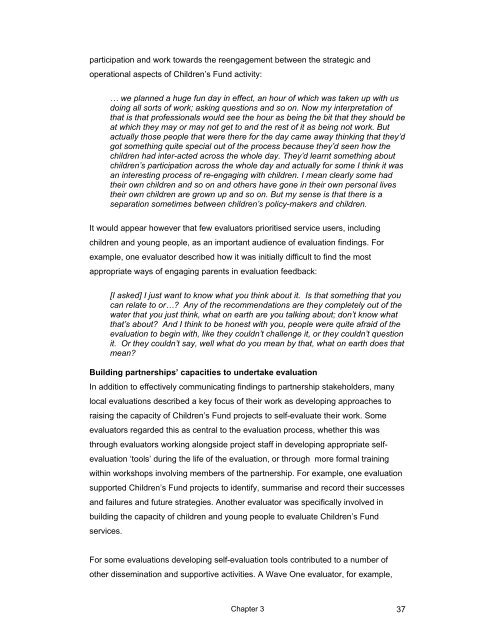Local Evaluation of Children's Services Learning from the Children's ...
Local Evaluation of Children's Services Learning from the Children's ...
Local Evaluation of Children's Services Learning from the Children's ...
- No tags were found...
You also want an ePaper? Increase the reach of your titles
YUMPU automatically turns print PDFs into web optimized ePapers that Google loves.
participation and work towards <strong>the</strong> reengagement between <strong>the</strong> strategic andoperational aspects <strong>of</strong> Children’s Fund activity:… we planned a huge fun day in effect, an hour <strong>of</strong> which was taken up with usdoing all sorts <strong>of</strong> work; asking questions and so on. Now my interpretation <strong>of</strong>that is that pr<strong>of</strong>essionals would see <strong>the</strong> hour as being <strong>the</strong> bit that <strong>the</strong>y should beat which <strong>the</strong>y may or may not get to and <strong>the</strong> rest <strong>of</strong> it as being not work. Butactually those people that were <strong>the</strong>re for <strong>the</strong> day came away thinking that <strong>the</strong>y’dgot something quite special out <strong>of</strong> <strong>the</strong> process because <strong>the</strong>y’d seen how <strong>the</strong>children had inter-acted across <strong>the</strong> whole day. They’d learnt something aboutchildren’s participation across <strong>the</strong> whole day and actually for some I think it wasan interesting process <strong>of</strong> re-engaging with children. I mean clearly some had<strong>the</strong>ir own children and so on and o<strong>the</strong>rs have gone in <strong>the</strong>ir own personal lives<strong>the</strong>ir own children are grown up and so on. But my sense is that <strong>the</strong>re is aseparation sometimes between children’s policy-makers and children.It would appear however that few evaluators prioritised service users, includingchildren and young people, as an important audience <strong>of</strong> evaluation findings. Forexample, one evaluator described how it was initially difficult to find <strong>the</strong> mostappropriate ways <strong>of</strong> engaging parents in evaluation feedback:[I asked] I just want to know what you think about it. Is that something that youcan relate to or…? Any <strong>of</strong> <strong>the</strong> recommendations are <strong>the</strong>y completely out <strong>of</strong> <strong>the</strong>water that you just think, what on earth are you talking about; don’t know whatthat’s about? And I think to be honest with you, people were quite afraid <strong>of</strong> <strong>the</strong>evaluation to begin with, like <strong>the</strong>y couldn’t challenge it, or <strong>the</strong>y couldn’t questionit. Or <strong>the</strong>y couldn’t say, well what do you mean by that, what on earth does thatmean?Building partnerships’ capacities to undertake evaluationIn addition to effectively communicating findings to partnership stakeholders, manylocal evaluations described a key focus <strong>of</strong> <strong>the</strong>ir work as developing approaches toraising <strong>the</strong> capacity <strong>of</strong> Children’s Fund projects to self-evaluate <strong>the</strong>ir work. Someevaluators regarded this as central to <strong>the</strong> evaluation process, whe<strong>the</strong>r this wasthrough evaluators working alongside project staff in developing appropriate selfevaluation‘tools’ during <strong>the</strong> life <strong>of</strong> <strong>the</strong> evaluation, or through more formal trainingwithin workshops involving members <strong>of</strong> <strong>the</strong> partnership. For example, one evaluationsupported Children’s Fund projects to identify, summarise and record <strong>the</strong>ir successesand failures and future strategies. Ano<strong>the</strong>r evaluator was specifically involved inbuilding <strong>the</strong> capacity <strong>of</strong> children and young people to evaluate Children’s Fundservices.For some evaluations developing self-evaluation tools contributed to a number <strong>of</strong>o<strong>the</strong>r dissemination and supportive activities. A Wave One evaluator, for example,Chapter 3 37
















